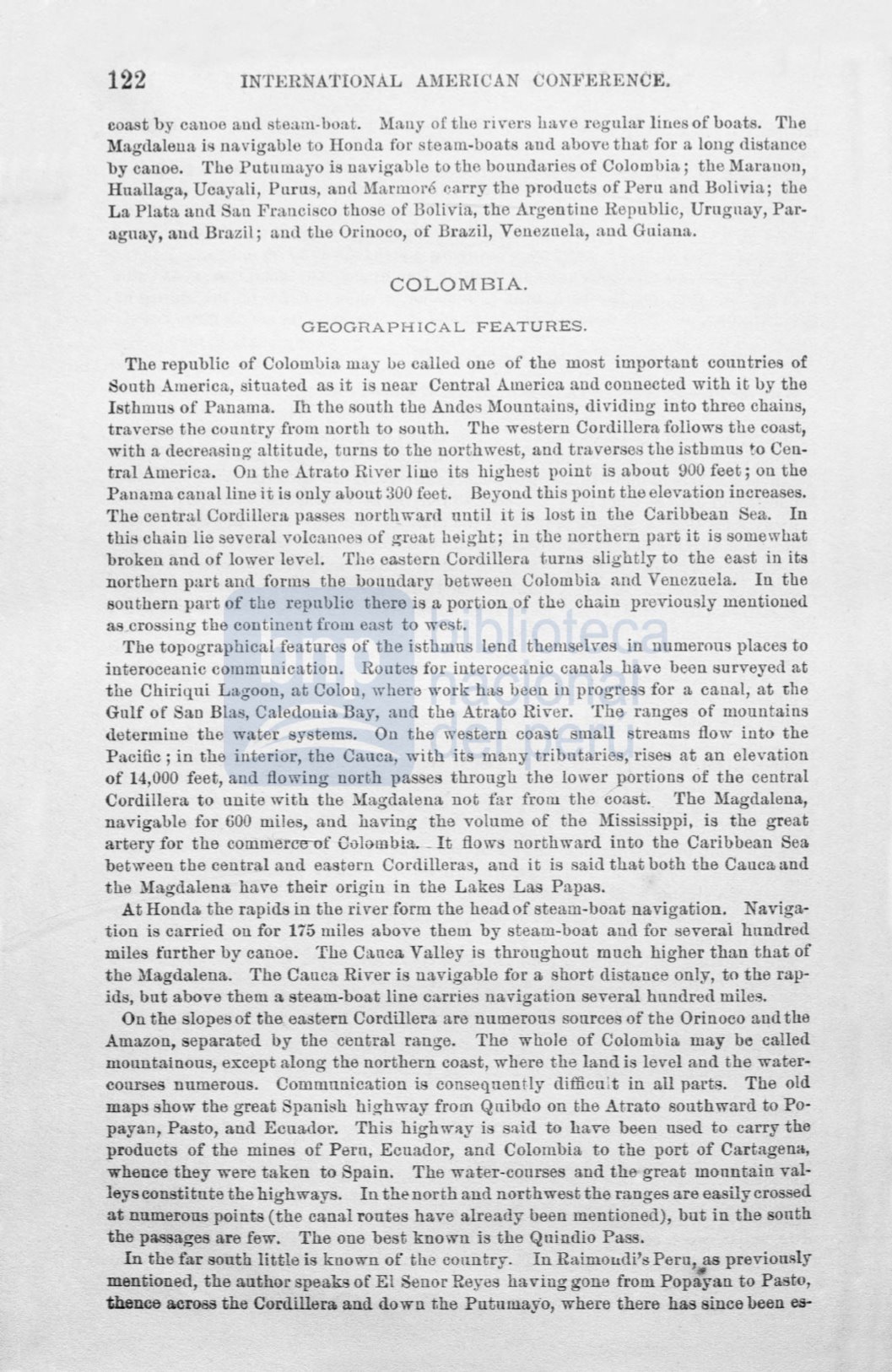

122
INTERNATIONAL AMERICAN CONJ<,ERENCE.
coast b y cauoe aud ste:Lm-bo:tt_ Ma.ny oí tlle river llave regular lines of boa-ts. Tbe
Magdalena is navigablc to Honda for steam-boats and above that for a long distance
by canoa. The Putnmayo is navigable tothe bounclaries of Colombia; the M<trauon,
Huallaga, Ucayali, Purus, anu Marmoré cl'J,rry the products ofPeru ancl Bolivia; the
La Plata ancl San Franci co those of Bolivia, the Argentiue Republic, Uruguay, Par–
aguay, auu Brazil; aml the Orinoco, of Brazil, Venezuela, and Guiana.
COLOMBIA.
GEOGRAPHICAL FEATURES.
The repnblic of Colombia may be callad one of the most important countries of
Soutb America, situated as it is near Central America and connected with it by the
Isthmus of Panama.
Ih tbe south the Ancles Mountaius, dividing into three chains,
traversa the country from north to !lOuth. Tbe western Cordillerafollows tlle coast,
with a decreasiug altitude, turns to the northwest, and traversas the istbmus toCen–
tra.! America. On the Atrato River line its highest point is about 900 feet; on the
Panama caualline
it
is only about 300 feet. Beyoncl this point the elevation increases.
The central Cordillertt pa ses northward uutil it is lost in the Caribbean Sea.
In
this chain lie several volcanoe of great height; in the northern part it is somewhat
broken and of lower level. The eastern Cordillera turna
lightly to the east in its
nortllern part and forros the boundary between Colombia and Venezuela.
In tbe
southern part of the republic there is a portion of the chain previously mentioned
as crossing the continent from east to west.
Tbe topographical featurc of the i thmns lend themselves in numerous placea to
interoceanic commuuicatiou. Routes for interoceanic canals have been surveyed at
the Chiriqui Lagoon, at Colon, where work h a been in progress for a canal, at the
Gulf of San Blas, Caledonia Bay, and the Atrato River. The ranges of mountains
determine the water sy tems. On the western coast small . treams flow into the
Pacific; in the interior, the Cauca, with its many tributaries, risca at an elevation
of 14,000 feet, and fiowing north pas es throngh the lower portions of the central
Cordillera to unite with the Magdalena not far from the coast.
The Magdalena,
navigable for (i00 miles, and having the volume of the Mississippi, is the great
artery for the commerce-of Colombia. _It flows northward into the Caribbean Sea
between the central and eastern Cordilleras, and
it
is aid that both the Canea a.nd
the Magdalena have their origin in the Lakes Las Papas.
At Honda the rapids
in
the river form the head of steam-boat navigation. Naviga–
tion is carried on for 175 miles above them by steam-boat and for severai hnnclred
miles further by canoa. The Canea Valley is throughout much higher tha.n that of
the Magdalena. The Canea River is na.vigable for a short distance only, to the rap–
ids, but above them a steam-boat line carries na.vigation severa! hnndred miles.
On the slopesof the eastern Cordillera are numeron sources of the Orinoco and tlle
Amazon, separated by the central ranga. The whole of Colombia may be called
mountainons, except along the northern coa t, wbere the land is level and the water–
courses numerous. Communication is con eqnently difficnlt in a.ll parts. The old
maps how the great Spanish hig-hwa.y from Qtübdo on the Atra.to southward toPo–
payan, Pasto, and Ecuador. This high
WllY
is said to llave been used to carry the
products of the mines of Peru, Ecuador, am1 Colombia to the port of Cartagena,
whence they were taken to Spain. The water-conrses and the great monntain val–
leys constitnte the highways.
In the north and northwest the ranges are easily crossed
at numerons points (the canal routes have already been mentioned), but in the onth
the p388age are few. The one best known is the Qnindio Pass.
In
the far onth little is known of the conntry.
In Raimoudi'd Pera, as previon. ly
mentioned, the author spea.ks of El &mor Reyes ha ving gone from Popayan to Pasto,
thence
aei'OBS the Cordillera and down the Putumayo, where there has since been es-
















